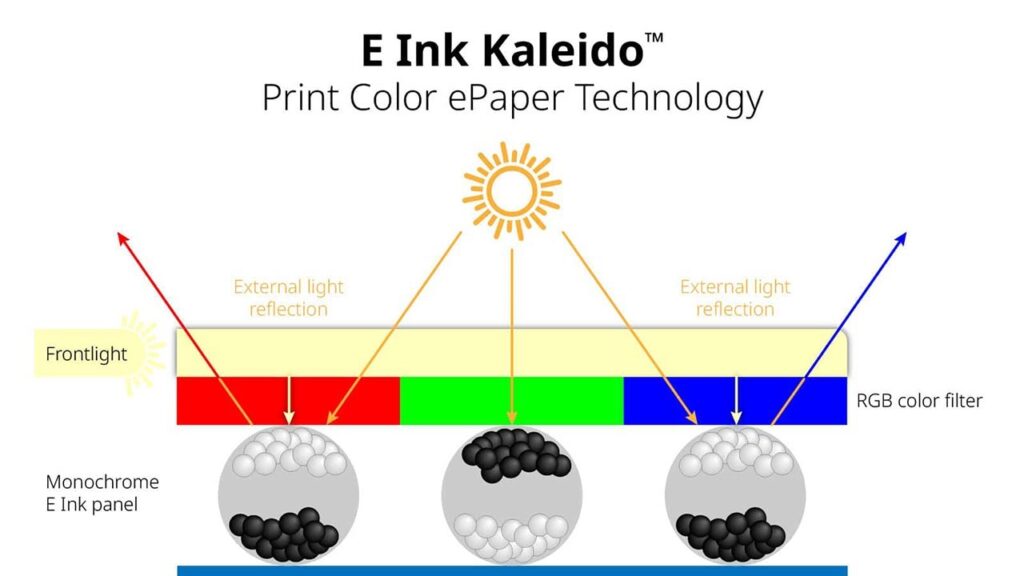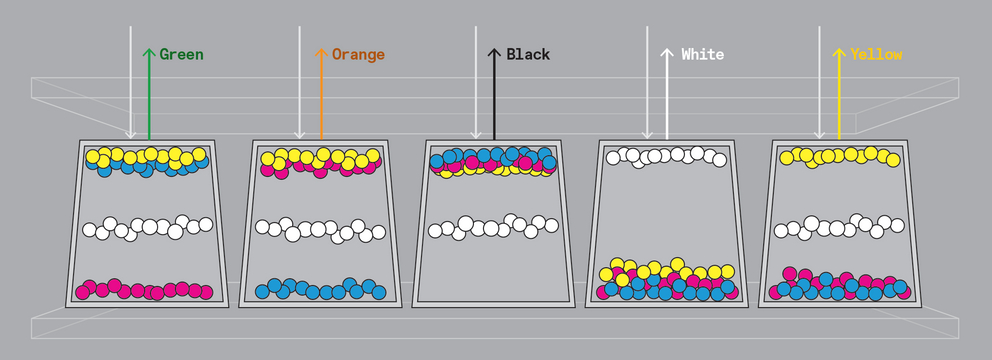Until now, e-Ink devices (electronic ink tablets or e-readers) used either black-and-white screens (Carta, based on a thin layer of glass, or Mobius, flexible screens) or Kaleido color screens. The latter featured a monochrome e-Ink display, similar to those found in standard black-and-white e-readers, overlaid with a lower-resolution color screen. While functional, these screens had drawbacks: reduced contrast, increased thickness, a grayer background, and noticeable latency.
With the arrival of the reMarkable Paper Pro, the market now offers a device equipped with E Ink’s latest innovation: the Gallery 3 screen. What sets it apart from its predecessor?
How does a Kaleido 3 screen works?
A Kaleido screen (found on most color e-readers, such as those produced by Kobo) is essentially a Carta e-Ink display (the most common technology, based on traditional e-Ink principles) with an added color layer. The diagram below illustrates the workings of such a screen.

This setup explains why Kaleido screens appear grayish and why their contrast is lower than that of a basic Carta screen. The additional layer enables color but blocks part of the light and distances the monochrome layer from the surface. This also accounts for why the black-and-white resolution is often higher than the color resolution: the display comprises two layers—an e-Ink panel for black-and-white rendering and a color filter panel that gives the impression of a colored background.
With the Gallery 3, E Ink offers a completely different product, marking a real entry into the world of full-color digital ink screens. Unlike Kaleido, Gallery 3 features a single color layer, providing consistent resolution across the entire color palette.
How does a Gallery 3 screen works?
A Gallery 3 screen is not simply a Carta screen with an added color layer. Instead, it uses color pigments to display a wide range of hues, as shown in the diagram below:

The technology retains the foundational principle of e-Ink: colored particles move in response to electrical impulses. When they reach the surface, a specific color becomes visible. Previously, e-Ink screens were limited to grayscale due to the underlying technology. That is no longer the case. With Gallery 3 screens, e-Ink technology can now display colors in much the same way it rendered grayscale.
Is a Gallery 3 better than a Kaleido 3 ?
To put it bluntly, a Gallery 3 screen significantly outperforms a Kaleido screen. Previously, it was often advisable to stick with black-and-white displays since color screens sacrificed clarity and contrast, which could hinder text readability. However, that is no longer the case.
While the contrast on Gallery 3 screens may still fall slightly short of black-and-white screens, the difference is minimal. The ability to display vibrant colors is a real advantage for certain use cases, such as reading comics, color-heavy PDFs, or charts that are difficult to interpret without color.
However, some devices, such as the SuperNote Manta, continue to feature black-and-white screens. Ratta/SuperNote justifies this choice by emphasizing the thinner profile of these screens and their pursuit of minimal latency. This may hold some truth, but cost differences likely also play a role. Regardless, the transition to color across most devices on the market doesn’t seem entirely necessary—black-and-white screens remain perfectly adequate for most purposes.
Industry Dynamics and Market Trends
It’s worth noting that E Ink Corporation holds a monopoly on the production of such screens. It has every incentive to innovate and patent technical advancements to maintain market dominance. Meanwhile, manufacturers of e-Ink tablets and e-readers find it challenging to stick with older technologies due to marketing pressures: when one competitor adopts color displays, others must follow suit to avoid losing sales.
This evolution is therefore driven primarily by industrial and marketing dynamics within a largely monopolistic capitalist system. E Ink must innovate, and manufacturers face pressure to adopt new technologies to differentiate themselves in the market.
Some companies, however, continue to prioritize black-and-white displays, such as SuperNote, mentioned earlier, and Amazon. The American giant’s latest Kindle Scribe, for instance, features a black-and-white screen! Kindle devices will likely switch to color eventually—but only once the technology matures. Skipping Kaleido may have been a wise decision, considering the major advancements from Kaleido 3 to Gallery 3.